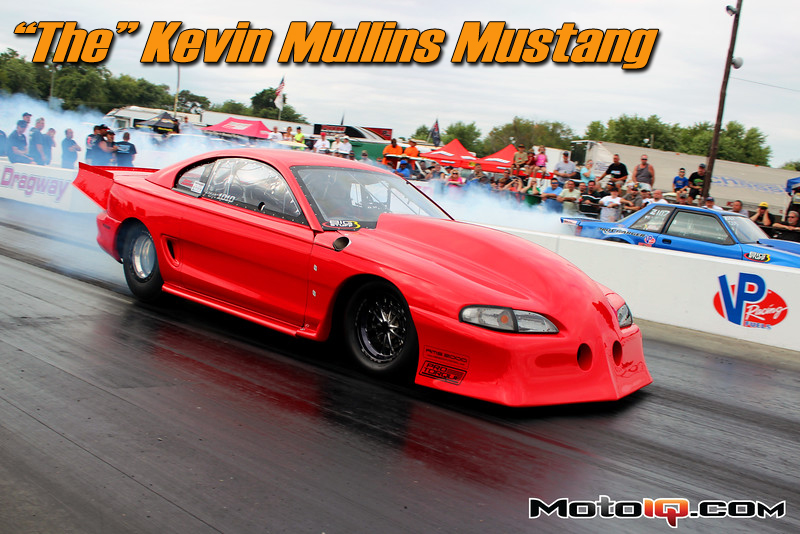,
 Unlike most road racing events (enduros excluded), it's very common for bigger drag races to run late into the night. Last-minute wrenching at 1:15AM before your 1:30AM call to the staging lanes is pretty normal. Mullins' Mustang is equpped with bright LED strips throughout the engine bay to add as much light as possible for these late-night thrashes. All the little things add up, and trying to make the weekend go as easily as possible reduces stress for everyone participating.
Unlike most road racing events (enduros excluded), it's very common for bigger drag races to run late into the night. Last-minute wrenching at 1:15AM before your 1:30AM call to the staging lanes is pretty normal. Mullins' Mustang is equpped with bright LED strips throughout the engine bay to add as much light as possible for these late-night thrashes. All the little things add up, and trying to make the weekend go as easily as possible reduces stress for everyone participating. For anyone who has ever driven a car with no door frames (older Subarus, the S13 240SX, etc) at high speed, you might be able to guess what this latch is for. It actually acts as a secondary door latch to keep the windows from pulling away from the rest of the chassis and flapping at close to 200MPH. The small button up top “closes” the latch, which helps secure the window frame into the roll cage. The big button “opens” the latch, and then the door handle does the rest.
For anyone who has ever driven a car with no door frames (older Subarus, the S13 240SX, etc) at high speed, you might be able to guess what this latch is for. It actually acts as a secondary door latch to keep the windows from pulling away from the rest of the chassis and flapping at close to 200MPH. The small button up top “closes” the latch, which helps secure the window frame into the roll cage. The big button “opens” the latch, and then the door handle does the rest. Around 3500 horsepower is funneled through these tiny shoes. When taking into consideration that most 1000HP+ street Supras rock similar amounts of tire, the amount of suspension and other tuning required of Mullins to propel this red rocket with 3x more power really starts to seem impressive. The original chassis builder completely fabricated a rear end – no standard Ford 9” parts here.
Around 3500 horsepower is funneled through these tiny shoes. When taking into consideration that most 1000HP+ street Supras rock similar amounts of tire, the amount of suspension and other tuning required of Mullins to propel this red rocket with 3x more power really starts to seem impressive. The original chassis builder completely fabricated a rear end – no standard Ford 9” parts here.While road racers have adopted all kinds of modified rear-end linkages for turning both left and right (Panhard, Watts, etc.), this Mustang employs a traditional 4-link. Straight, equal-length links with telescoping/sliding wishbones for lateral centering are used. Menscer Motorsports helped Kevin with the initial set-up of the 4-link angles and shock tuning.
 Menscer Motorsports shocks are used out back. Menscer custom-builds their drag shocks with unique base valves, valve bodies and piston assemblies specifically for radial tire (and other) cars. Because of the sidewall construction and stiffness of the radial, seriously heavy duty shock control is required. Another set of Strange brakes is out back, and one of the rear suspension travel sensors is visible to the right of the shock. What's out of frame is the infrared tire temperature sensor that keeps tabs on the radial throughout the run.
Menscer Motorsports shocks are used out back. Menscer custom-builds their drag shocks with unique base valves, valve bodies and piston assemblies specifically for radial tire (and other) cars. Because of the sidewall construction and stiffness of the radial, seriously heavy duty shock control is required. Another set of Strange brakes is out back, and one of the rear suspension travel sensors is visible to the right of the shock. What's out of frame is the infrared tire temperature sensor that keeps tabs on the radial throughout the run. While floppy “big tire” slicks can be more forgiving if things go wrong, radials either hit right and go, or don't. The shift either blows the tires off (wheelspin and loss of traction) or it doesn't. There's not a lot of room for error, and having to pedal the car means the run is pretty much lost. Fortunately, Mullins has great partners and sponsors, and all of them together should easily be able to best their 4.113 at 193MPH.
While floppy “big tire” slicks can be more forgiving if things go wrong, radials either hit right and go, or don't. The shift either blows the tires off (wheelspin and loss of traction) or it doesn't. There's not a lot of room for error, and having to pedal the car means the run is pretty much lost. Fortunately, Mullins has great partners and sponsors, and all of them together should easily be able to best their 4.113 at 193MPH.


